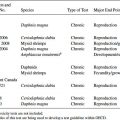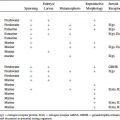html xmlns=”http://www.w3.org/1999/xhtml”>
CHAPTER 1
Ecotoxicity Test Methods for Endocrine-Disrupting Chemicals
AN INTRODUCTION
1.1 BACKGROUND
The issue of endocrine disruption has been something of a cause célèbre since it was first identified as an issue about 25 years ago. Few scientists had previously suspected that certain synthetic chemicals might be able to interfere with the workings of the endocrine system at low concentrations. However, in the mid-1990s, Theo Colborn and others [1] brought this subject to the attention of a wide audience when it became clear that many different wildlife species were experiencing effects that were attributable to damaged hormone signaling. Since then, endocrine-disrupting chemicals (EDCs) have come to be treated as a special case rather like carcinogens, so that the mere possession of endocrine-disrupting (ED) properties can be enough to trigger precautionary regulatory action in some jurisdictions, irrespective of the probable environmental risks involved. In other jurisdictions, the risks of EDCs are being evaluated in similar ways to non-EDCs, but these chemicals are the subject of much concern irrespective of the regulatory stance being taken.
It is therefore extremely important that EDCs should be unambiguously identified and their hazards accurately measured. This book represents one of the first attempts to describe and critically evaluate the methods that have been developed for studying the effects of EDCs on mammalian and nonmammalian wildlife in the laboratory.
The chapters in this volume are aimed at scientists and chemical companies that wish to investigate the ecotoxicological properties of EDCs using cutting-edge and (where relevant) internationally agreed techniques and at chemical regulatory authorities that seek to protect the environment from the adverse effects of EDCs through the use of rigorous hazard evaluation programs that employ scientifically sound methods. This is quite an ambitious aim, given that some standardized assays that use wildlife species to assess the toxicity of EDCs are still in development, and there remain whole classes of EDCs for which assays have not yet been standardized or even designed. However, despite these gaps and limitations, it is hoped that the book will provide useful guidance until a more comprehensive array of test methods becomes available.
Chapter 2 by Dick Vethaak and Juliette Legler describes why some EDCs became recognized as an environmental problem in the 1980s, and summarizes the large amount of research that has since discovered many features of this disparate group of chemicals. The chapter brings us up to date about the chemicals that have been found to have ED properties and surveys effects observed in the field and in the laboratory. This review makes it clear that, until recently, chemical risk assessment schemes had failed to prevent some EDCs from entering the environment and causing sometimes severe damage to certain ecosystems. Thus, the chapter sets the scene for the ones that follow.
1.2 REGULATORY CONCERNS
In Chapter 3, Hans-Christian Stolzenberg and coauthors explain why regulatory authorities have become concerned about EDCs and describe in detail how several authorities (especially Japan, the United States, and the European Union) have responded with new programs and regulations designed to identify these chemicals and assess their hazards and associated environmental risks. It became apparent from the early 1990s that existing internationally standardized ecotoxicity assays were largely insensitive to EDCs. As a result of this understanding, member countries of the Organisation for Economic Cooperation and Development (OECD) initiated a program to develop and validate new testing methods. The chapter indicates how these methods are likely to be used in chemical regulatory activities in several jurisdictions, although full details are still being developed and many other jurisdictions have yet to act.
1.3 INVERTEBRATES
The regulatory background is then followed by three chapters that describe testing methods with certain invertebrate groups (insects, crustaceans and molluscs) and five chapters covering methods using vertebrates (fish, amphibians, reptiles, birds, and mammals). At present, regulatory requirements for the testing of suspected EDCs are restricted to vertebrates alone, but this is due mainly to the fact that invertebrate endocrine systems are relatively poorly understood, not because endocrine disruption is not an issue in these phyla.
Stay updated, free articles. Join our Telegram channel

Full access? Get Clinical Tree








